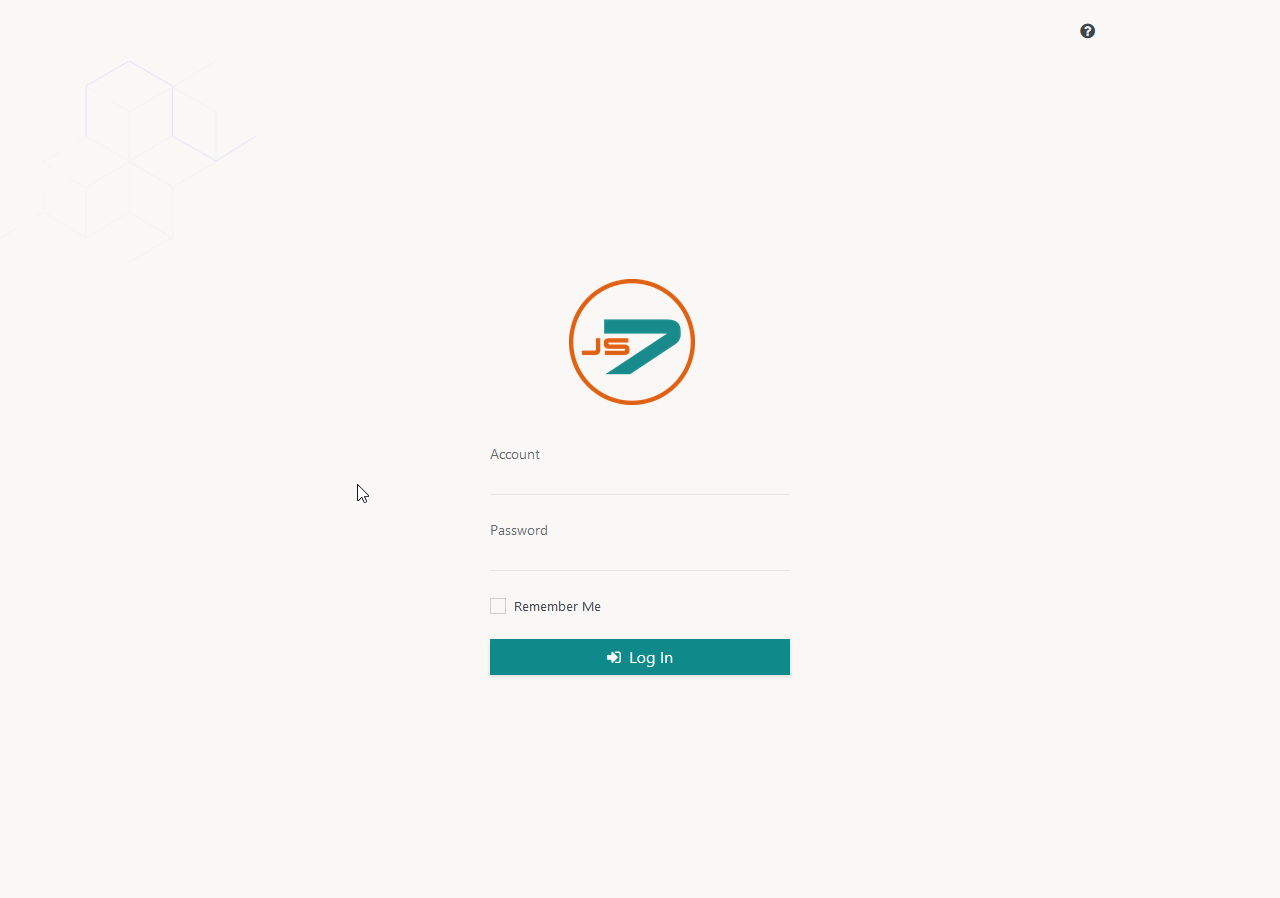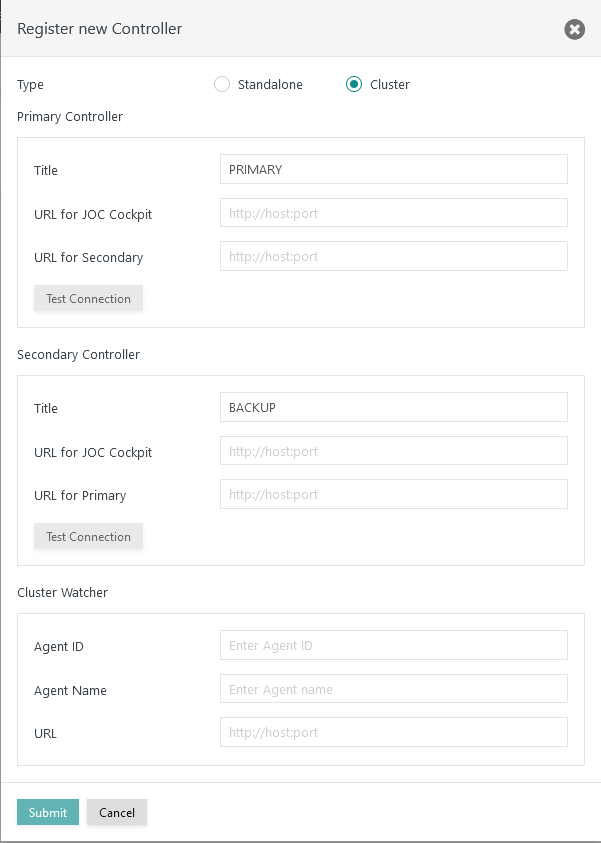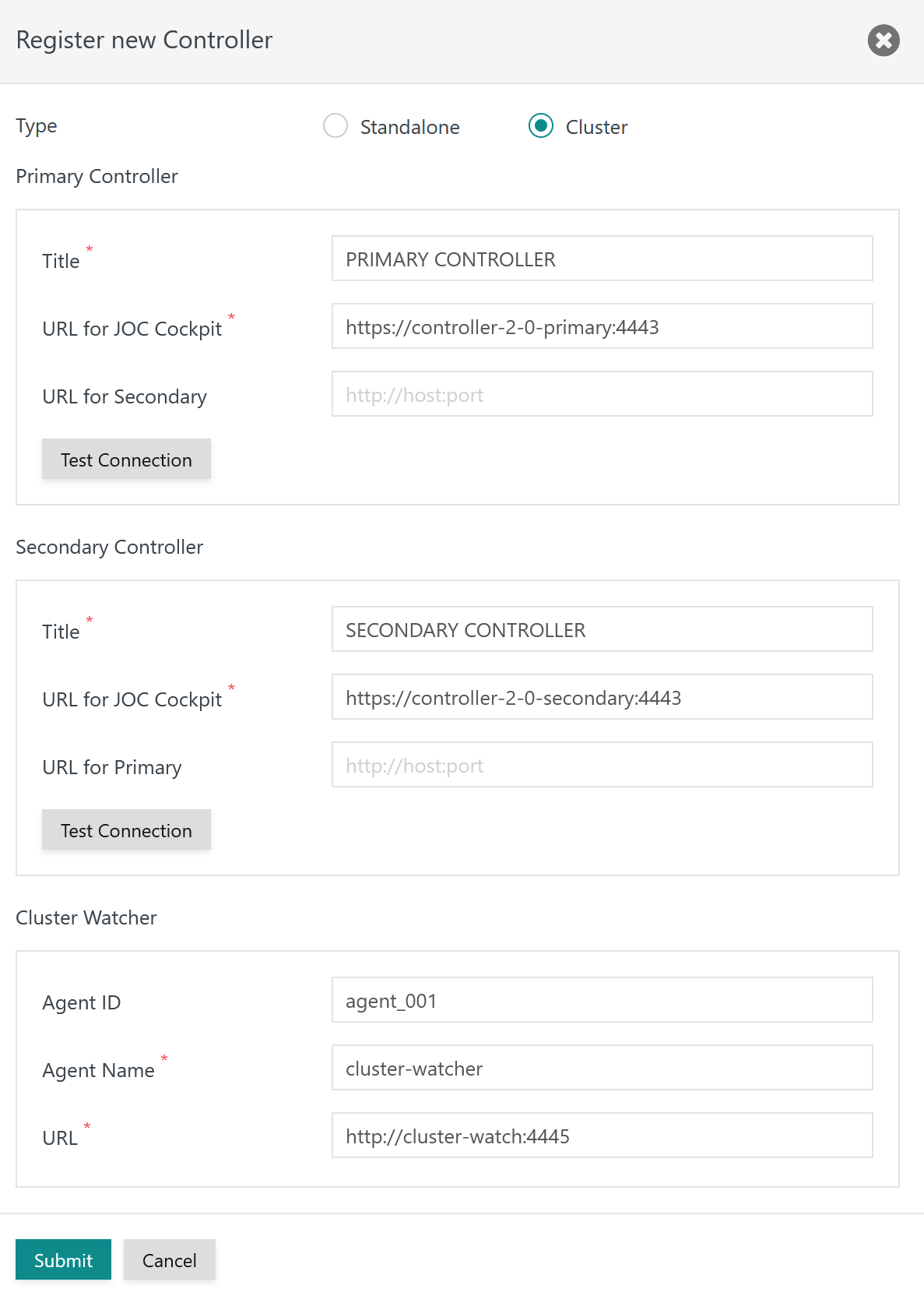Page History
| Table of Contents |
|---|
Introduction
Initial Operation is performed after installation of the JS7 Controller, Agent
...
and JOC Cockpit.
Operation of a Controller Cluster is subject to the agreements of the JS7 - License.
- Use of Standalone Controllers:
- available to Open Source License holders and to commercial license holders.
- for details see JS7 - Management of Standalone Controllers.
- Use of Controller Clusters:
- available to commercial license holders,
For a Controller Cluster initial operation includes
- requires a commercial license, see JS7 - License.Tasks include applying the license key and licensed binary code.
- Tasks include registering the Controller Cluster and Agents.
...
Initial Operation requires that a JS7 Controller, Agent , Controller and JOC Cockpit have been successfully installed and are up and running.
...
Controller Cluster Checks
| Anchor | ||||
|---|---|---|---|---|
|
...
Checking the Controller ID
Both Controller instances for in a Cluster cluster have to be installed with the same Controller ID, which is a unique identifier for the Controller Cluster.
...
- Stop the Controller service:
- Unix, Windows: Stop the Controller from the command line, see JS7 - Controller - Command Line Operation.
- Windows: Stop the Controller from the Windows service panel.
- Remove Controller journal files:
- The journal files have to be removed from the configuration directory with the
statesub-folderdirectory. This means that any orders, which have been submitted for workflows will be removed and that workflows will have to be redeployed:- Unix:
rm -f /var/sos-berlin.com/js7/controller/state/* - Windows:
del C:\ProgramData\sos-berlin.com\js7\controller\state\*
- Unix:
- Note that a different location for the configuration directory can be specified during installation.
- The journal files have to be removed from the configuration directory with the
- Modify the Controller ID:
- Users can modify the Controller Instance Start Script that holds the environment variable:
JS7_CONTROLLER_ID=<controller-id>- Unix: The
- Controller ID is specified
- with the
bin/
controller_
instance.sh
- Instance Start Script, see JS7 - Controller - Headless Installation on Linux/Windows.
- Modify the following environment variable:
JS7_CONTROLLER_ID=<controller-id>- Windows: The Controller ID is specified with the
bin\controller_instance.cmdInstance Start Script.
- For Windows users can run the graphical installer to Windows: If the installer has been used (in headless mode or in graphical mode), then reinstall the Controller, see JS7 - Controller - Installation Using the Windows Graphical Installer.
- Users can modify the Controller Instance Start Script that holds the environment variable:
- Restart the Controller instance.
| Anchor | ||||
|---|---|---|---|---|
|
...
Checking the Cluster Settings
The secondary Controller has to use the following configuration from its config/controller.conf file, see JS7 - Controller Configuration Items:
...
If changes to the above configuration are required then users can carry out the following steps for the secondary Controller instance:
- Stop the Controller service:
- Unix, Windows: Stop the Controller from the command line, see JS7 - Controller - Command Line Operation.
- Windows: Stop the Controller from the Windows service panel.
- Remove Controller journal files:
- The journal files have to be removed from the configuration directory with the
statesub-folderdirectory. This means that any orders that have been submitted for workflows will be removed and that workflows will have to be redeployed:- Unix:
rm -f /var/sos-berlin.com/js7/controller/state/* - Windows:
del C:\ProgramData\sos-berlin.com\js7\controller\state\*
- Unix:
- Consider that a different location for the configuration directory can be specified during installation.
- The journal files have to be removed from the configuration directory with the
- Modify the the
config/controller.conffile to reflect the above the js7.journal.cluster.node.is-backup=yessetting. - Restart the Controller instance.
Adding License Key and Licensed Binary Code
Customers possessing holding a commercial license will receive a license key from SOS and can download the binary code that allows clustering of JS7 components, see JS7 - Download.
...
- The license key can be added during installation of each Controller instance and each JOC Cockpit instance.
- The license key can be added later on by storing the license certificate file in the following locations:
- Unix: Controller Configuration Directory configuration directory with
licensesub-folderdirectory.- Default Locationlocation:
/var/sos-berlin.com/js7/controller/config/license - A different location for the configuration directory can be specified during installation.
- Default Locationlocation:
- Windows: Controller Configuration Directory with
licensesub-folderdirectory.- Default Locationlocation:
C:\ProgramData\sos-berlin.com\js7\controller\<controller-id>\config\license- where
<controller-id>is the unique identifier for the Controller that is specified during installation.
- where
- A different location for the configuration directory can be specified during installation.
- Default Locationlocation:
- Unix: Controller Configuration Directory configuration directory with
...
- Binary code for clustering is available from the
js7-license.jarfile, which can be obtained from JS7 - Download. - By downloading the binary code for clustering you users consent with the license terms for a commercial license of JS7.
- The
js7-license.jarfile has to be stored to the following locationslocation:- Unix: Controller Installation Directory installation directory with
lib/user_libsub-foldersdirectory:- Default Location location:
/opt/sos-berlin.com/js7/controller/lib/user_lib - A different location for the installation directory can be specified during installation.
- Default Location location:
- Windows: Controller Installation installation Directory with
lib\user_libsub-foldersdirectory:- Default Locationlocation:
C:\Program Files\sos-berlin.com\js7\controller\lib\user_lib - A different location for the installation directory can be specified during installation.
- Default Locationlocation:
- Unix: Controller Installation Directory installation directory with
...
Basically the same locations for license key and licensed binary code apply as already explained for Unix operating systems in previous chapters.
Note that there is no : No access to the container's file system is available before the container is running, which makes it impossible to add or replace licensed binary code before the Controller has been started.
Adding a License Key
- The license key can be added by storing the license certificate file in the following location:
/var/sos-berlin.com/js7/controller/config/license- The directory
/var/sos-berlin.com/js7/controlleris typically mounted to from a Docker var volume when running the container, for details see JS7 - Controller Installation for Docker Containers
...
- Binary code for clustering is available from the
js7-license.jarfile, which can be obtained from JS7 - Download. - By downloading the binary code for clustering you users consent with the license terms for a commercial license of JS7.
- The
js7-license.jarfile has to be stored in the following locationslocation:/var/sos-berlin.com/js7/controller/config/lib- The directory
/var/sos-berlin.com/js7/controllertypically is mounted in from a Dockervarvolume when running the container: for details see JS7 - Controller Installation for Docker Containers. - If the sub-directory
config/libdoes not exist then you can create it before storing thejs7-license.jarfile.
On startup start-up the Controller checks the above directory for existence of the js7-license.jar file. If the file is found then
...
Login to JOC Cockpit User Interface
...
Users can navigate with their browser to the JOC Cockpit URL and enter the User Account and Password. Typically the URL will include the hostname and port that JOC Cockpit has been installed
...
for:
For example,
addinghttp://myhost:4446. Check that the JOC Cockpit port is accessible. This might requireadditional firewall rules to allow access to
thisthe port from the computer that
you operatethe
browser onuser's browser is operated for.
After initial installation of JOC Cockpit the default
User Accountuser account
Passwordrootandpassword
will be available if no changes have been made to therootshiro.iniconfiguration fileare available.
Note
...
: The root user is assigned the all role in the default configuration and
...
is granted all available permissions.
...
For details see the JS7 - Identity Services and JS7 - Authentication articles.
Note: JOC Cockpit might take a number of seconds
...
to start and to display the login window.
Register Controller and Agents
After successful login to JOC Cockpit a dialog window for registering a Controller is showndisplayed. You Users will find the same dialog later on via the User -> Manage Controllers/Agents menu itemview.
You Users have a choice to register of registering a Standalone Controller (within scope of the JS7 Open Source License) or a Controller Cluster for high-availability (requires a within scope of the JS7 Commercial License, see JS7 - LicensingLicense).
| Anchor | ||||
|---|---|---|---|---|
|
A Controller Cluster implements high-availability for automated fail-over should a server node operating the Controller instance be aborted or killed or become unavailable.
Explanation
This dialog allows the Primary Controller instance, the Secondary Controller instance and an Agent Cluster Watcher to be specified.
Explanation
- Title: The title added for each Controller instance will be shown in is displayed with the JS7 - Dashboard view.
- URL for JOC Cockpit: Primary and Secondary Controller instances require a URL as seen from JOC Cockpit. This URL is used by JOC Cockpit to connect to the relevant Controller instancesare accessed by this URL from JOC Cockpit.
- The URL
- includes the protocol, hostname and port that the relevant Controller instance is operated for.
- By default the HTTP protocol is used. The HTTPS protocol can be used if TLS/SSL certificates are in place, see JS7 - Controller HTTPS Connections.
- URL for Secondary / URL for Primary: The Primary Controller establishes a connection to the Secondary Controller and vice versa.
- Input to this field is not required if the URL for a Controller instance is the same across the network.
- Input to this field is required should Proxy Services be involved that make use of specific URLs.
- Cluster Watcher: An Agent The Agent Cluster Watcher is required for operation of a Controller Cluster. The Agent is contacted by both Controller Cluster members to verify the cluster status should a direct connection between Controller Cluster members not be available.
- Agent ID: The Agent is assigned an
Agent IDwhich is a unique identifier for this Agent and . Uniqueness is applied for all Agents registered with the same Controller. The Agent ID cannot be modified during the lifetime of an Agent. Change of Changes to the Agent ID requires the removal require the Agent to be removed and re-addition of the Agent added with JOC Cockpit. It is not necessary to uninstall/reinstall the Agent. - The Agent Name is a unique identifier that : The name of an Agent is used for example in the JOC Cockpit Configuration view to assign Agents when assigning the Agent to jobs. The Similarly to the Agent ID the Agent Name has to be unique but can be modified changed later on.
- The Agent URL is the hostname : The protocol HTTP or HTTPS, host name or IP address and port for by which the Agent is operatedis accessible to the Controller.
- By default the HTTP protocol is used. The HTTPS protocol can be used if TLS/SSL certificates are in place, see JS7 - Agent HTTPS Connections.
- Agent ID: The Agent is assigned an
Note
...
: The following connections should be accessible and
...
might require
...
additional firewall rules to allow access to the relevant ports:
- JOC Cockpit connection
- to the Primary Controller host and port.
- JOC Cockpit connection to the Secondary Controller host and port.
- Primary Controller connection
- to the Secondary Controller host and port.Secondary Controller connection to the Primary Controller
- to the Cluster Watcher Agent host and port.Primary
- Secondary Controller connection
- to the Primary Controller to the Cluster Watcher Agent host and port.
- Secondary Controller connection to the Cluster Watcher Agent host and port.
For more information about network connections see JS7 - System Architecture.
| Anchor | ||||
|---|---|---|---|---|
|
After the connection between JOC Cockpit and the Controller is established you users can add Agents. To register an Agent, switch to the Manage Controller/Agents view from the user menu. Click on the Action Menu of the Controller for which an Agent should be registered and select Add Agent.
The icon in the JOC Cockpit main menu offers to select the Manage Controllers/Agents view:
To add a Standalone Agent users can start from the Controller's action menu to which the Agent should be added:
This brings forward the following popup window:
Explanation:
- The Agent is assigned an Agent ID which is a : A unique identifier for this Agent that cannot be modified during the lifetime of an Agent. Change of the
Agent IDrequires the removal of and re-addition of the Agent with the JOC Cockpit. It is not necessary to uninstall/reinstall the Agent. - The
Agent Nameis a unique identifier that is used for example in the Configuration view to assign Agents to jobs. TheAgent Namecan be modified later on. - In addition, you can add
Agent Alias Namesto make the same Agent available by different names. - of the Agent. Uniqueness is applied for all Agents registered with the same Controller. This identifier cannot be changed later on.
- Agent Name: The name of an Agent is used for example when assigning the Agent to jobs. Similarly to the Agent ID the Agent Name has to be unique but can be changed later on.
- Title: An individual description that can be searched for.
- URL: The protocol HTTP or HTTPS, host name or IP address and port by which the Agent is accessible to the ControllerThe
Agent URLincludes the protocol, the hostname and port for which the Agent is operated.
Further References
- Installation
- Operation
- Configuration
...





